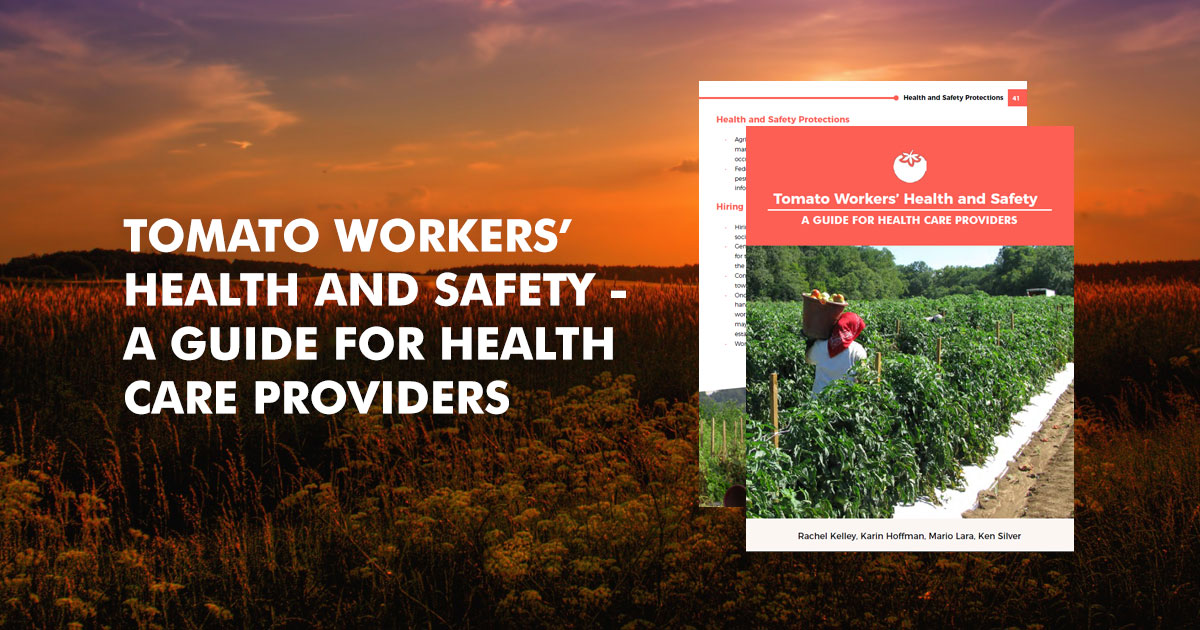This page highlights important tools for clinicians as well as diagnoses to consider when caring for disaster-affected patients.
United for Puerto Rico is an initiative brought forth by the First Lady of Puerto Rico, Beatriz Rosselló, in collaboration with the private sector, with the purpose of providing aid and support to those affected in Puerto Rico by the passage of Hurricane Irma and Hurricane María. 100% of the proceeds will go to helping the victims afteced by these natural disasters in Puerto Rico.
This site includes various helpful links including information on health hazards, mold remediation, respirator use, and related policy information.
Comprehensive flood information including links to preparedness and response/recovery pages.
Comprehensive hurricane information including links to preparedness and response/recovery pages.
"To assist health centers in obtaining Federal Emergency Management Agency (FEMA) funding for damaged or destroyed facilities, Capital Link has developed Hurricane Recovery Resources for Health Centers, supported by the Health Resources and Services Administration."
"The Human Diagnosis Project (also referred to as "Human Dx" or "the Project") is a worldwide effort created with and led by the global medical community to build an online system that maps the best steps to help any patient. By combining collective intelligence with machine learning, Human Dx intends to enable more accurate, affordable, and accessible care for all."
A resource by the CDC highlighting the symptoms and signs of carbon monoxide poisoning, which is often a cause of illness and death after a natural disaster.
"Carbon monoxide (CO) is an odorless, colorless, poisonous gas that can cause sudden illness and death if present in sufficient concentration in the ambient air. When power outages occur during emergencies such as hurricanes or winter storms, the use of alternative sources of fuel or electricity for heating, cooling, or cooking can cause CO to build up in a home, garage, or camper and poison the people and animals inside." - CDC
California's Medical Supervision Program is a biomonitoring program that measures cholinesterase activity in bloog samples from agricultural workers. Employers are required by law to contract with physicians who have registered for this program, all of whom are included in this list.
Safety and Health Practicesfor Nail Salon Workers and a Training Guide for Nail Salon Worker Safety and Health Outreach Program
- Best_Practices_HOPE.pdf (230 KB)
- Trainer_Guide_HOPE.pdf (1.34 MB)
Resources in English and Spanish from Florida State University's Center for Child Stress and Health on how to talk to a child about deportation and associated stress.
- CCSH_Deportation_EN.pdf (72.55 KB)
- CCSH_Deportation_SP.pdf (70.94 KB)
Available in English and Spanish!
Created by MCN, medical student Rachel Kelley of UCSF, and collaborators at East Tennessee State University, this guide is intended to be a reference for health care providers who work with people employed in the U.S. tomato industry. It aims to prepare providers with a more detailed understanding of hazards, health issues, and work processes associated with different tomato industry jobs.
This guide draws on published research, experienced health professionals’ advice, and information gathered from interviews and focus groups conducted with 36 tomato workers from diverse backgrounds and 14 community leaders familiar with tomato workers’ health in multiple states. It is important to note that health and safety conditions at any particular farm or company may vary from what is described here. Furthermore, individual workers may experience the same set of conditions differently.
The first section of the guide focuses on health hazards and health conditions commonly encountered in tomato production. The second section consists of detailed descriptions and illustrations of different tomato production tasks. The third section covers “human resources” information and policies that apply to U.S. agricultural workers generally. The appendices contain a Spanish-English glossary, further detail about different types of pesticides, information about agricultural occupational health policies and regulation, and a list of resources and readings.
A kit from the CDC designed to help reduce the risk of infection by the Zika virus. "If you live in a state or area with the mosquito that spreads the Zika virus and are concerned about Zika, build your own Zika Prevention Kit (...). Reducing the risk for Zika is particularly important for pregnant women."
Information from the CDC on the Zika Virus and pregnant women.
Zika educatinal materials from the Texas Department of State Health Services which includes fact sheets, push cards, posters, and TV PSAs. Available in both English and Spanish.

FECHA DE GRABACION: 5 de Abril de 2017, 1 pm ET (zona horaria del Este)
ORADORA: Ileana Ponce-González, MD, MPH, CNC
Crédito de educación continua
Para recibir credito de Trabajador/a de Salud Comunitaria o Educacion de Continua de Enfermera después de ver alguno de estos seminarios usted debe hacer lo siguiente:
- Completar la evaluación participante asociado a cada webinar
- Enviar un correo electrónico con su nombre y apellido indicando que ha completado a contedu@migrantclinician.org
Descripción
En este webinar, los participantes podrán identificar las medidas de desempeño de la Administración de Servicios de Recursos de Salud relacionadas con la hipertensión, describir cómo medir la hipertensión en el cuerpo, entender cómo alentar a los pacientes a controlar y manejar su presión arterial alta y entender las principales barreras que enfrentan pacientes en el control y manejo de su presión arterial alta.
Objetivos de aprendizaje
- Identificar los síntomas y signos de presiones sanguíneas altas
- Describir cómo se puede medir la hipertensión en el cuerpo
- Alentar a los pacientes a controlar y manejar su presión arterial alta
- Comprender las principales barreras que enfrentan los pacientes en el control de su presión arterial alta
Lectura Adicional
- HRSA: Hypertension Controls
- NIH: Help Your Heart: Control Your High Blood Pressure - Handouts
- NIH: Description of High Blood Pressure
- NIH: How Is High Blood Pressure Treated?
- NIH: Impediments to and potential strategies for effective blood pressure control
- USPSTF, AAFP Finalize Hypertension Screening Recommendations for Adults
- WSDF: Improving the Screening, Prevention, and Management of Hypertension
Este proyecto cuenta con el apoyo de la Administración de Recursos y Servicios de Salud (HRSA) del Departamento de Salud y Servicios Humanos de los Estados Unidos bajo el acuerdo de cooperación número U30CS09742, Asistencia Técnica a Centros de Salud Comunitarios y Migrantes y Personas sin Hogar por $ 1,094,709.00 con 0% del total Proyecto NCA financiado con fuentes no federales. Esta información o contenido y las conclusiones son las del autor y no deben ser interpretadas como la posición o política oficial de, ni cualquier endosos deben ser inferidos por HRSA, HHS o el Gobierno de los Estados Unidos.
- http://migrantclinician.adobeconnect.com/p71v9ojksgg/?OWASP_CSRFTOKEN=19499ccb24fdb83af0f6a5e559d20d4f5fffa5406927c78fbb67676b38141c94
- http://www.hrsa.gov/quality/toolbox/measures/hypertension/
- https://www.nhlbi.nih.gov/health-pro/resources/heart/hispanic-health-manual/session-4#handouts
- https://www.nhlbi.nih.gov/health/health-topics/topics/hbp
- https://www.nhlbi.nih.gov/health/health-topics/topics/hbp/treatment
- https://www.ncbi.nlm.nih.gov/pmc/articles/PMC1993926/table/tbl1/
- http://www.aafp.org/news/health-of-the-public/20151015htnprevrec.html
- https://www.healthit.gov/sites/default/files/13_bptoolkit_e13l.pdf
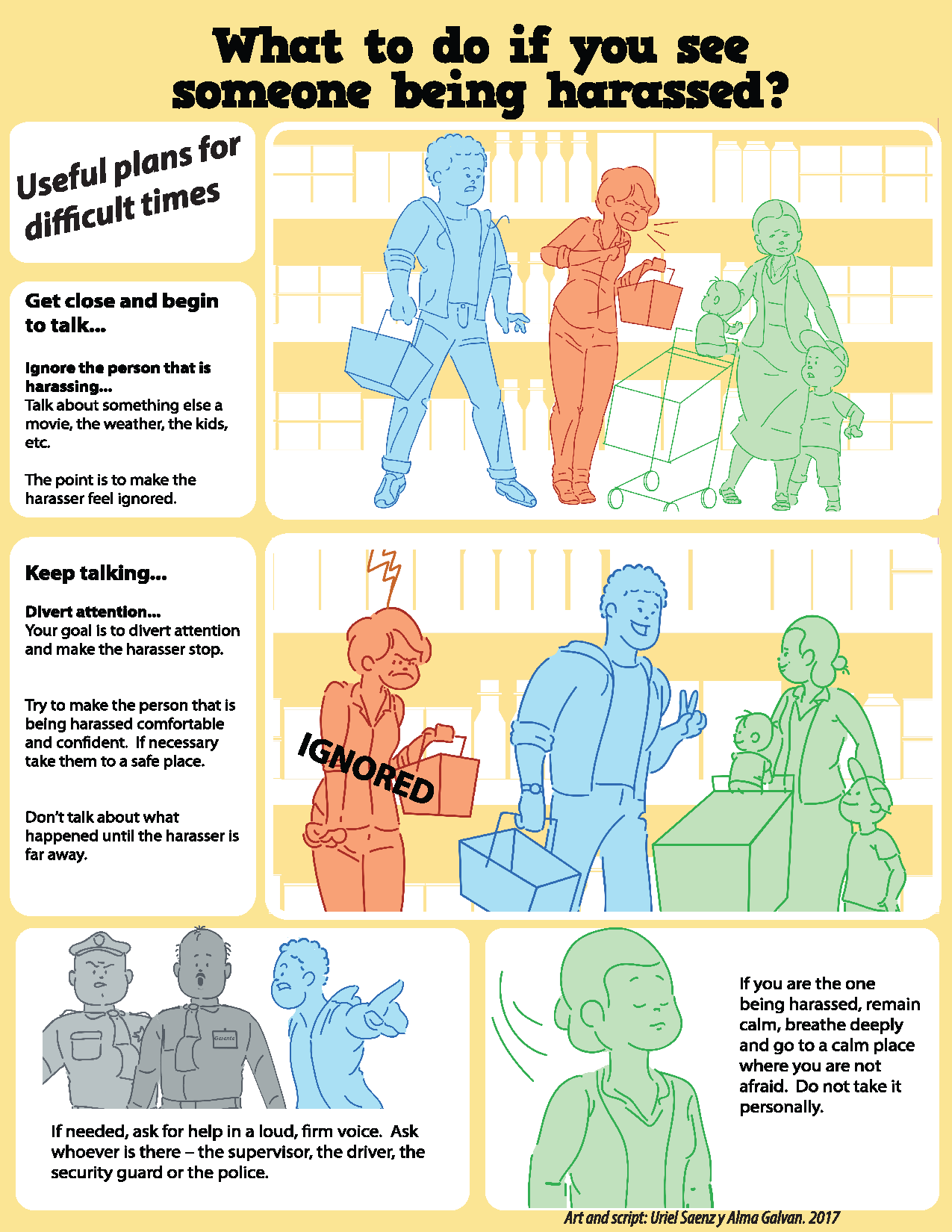
A guide to know how to react when you see someone being harassed. Art and script by Uriel Saenz and Alma Galván.
Chapter 14: Pesticides Are Poison from the Hesperian.org health guide: A Community Guide to Environmental Health.
Includes EPA manual "How to Comply With the 2015 Revised Worker Protection Standard For Agricultural Pesticides - What Owners and Employers Need To Know" and an excerpt specifically for clininicians regarding medical evaluation and respirator fit test. See also the medical evaluation questions in English and Spanish.
A flier created by the CDC's National Diabetes Education Program as a guide for patients in the management of medicines to treat diabetes. Available in English.
- Diabetes and You - All Medicines Matter.pdf (442.21 KB)
This 90-minute webinar was created for physicians, nurses, and other health professionals who treat and case manage patients with active TB. The webinar introduced the 2016 Official American Thoracic Society/Centers for Disease Control and Prevention/Infectious Diseases Society of America Clinical Practice Guidelines: Treatment of Drug-Susceptible Tuberculosis. This training highlighted the guidelines development process, the key changes in recommendations, and discussed the evidence supporting the changes. The webinar was originally presented on November 4, 2016. This training was jointly sponsored by all 5 RTMCCs.
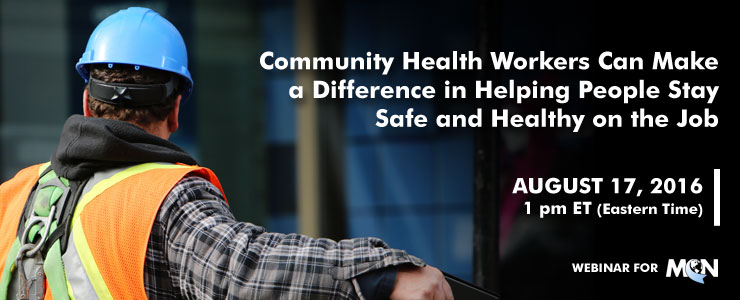
DATE RECORDED: August 17, 2016 at 1 pm ET
PRESENTED BY: Amy Liebman, MPA, MA and Wilson Augustave, member of MCN’s Board of Directors and Senior HIV Case Manager at Finger Lakes Community Health
This material will be produced under grant number SH-27640-15-60-F-48-SH5 from the Occupational Safety and Health Administration, U.S. Department of Labor. It will not necessarily reflect the views or policies of the U.S. Department of Labor, nor does mention of trade names, commercial products, or organizations imply endorsement by the U.S. Government.
- http://migrantclinician.adobeconnect.com/p50hmpih2ti/?OWASP_CSRFTOKEN=3e2b187aeeb1282a41d5df37d8a98c307a7e00006662aca9d5f21dc12aa036c4
- http://www.migrantclinician.org/
- http://workerscomphub.org/
- http://workerscomphub.org/navigating-system
- https://www.osha.gov/workers/index.html
- http://www.coshnetwork.org/know-your-rights
- http://hesperian.org/books-and-resources/
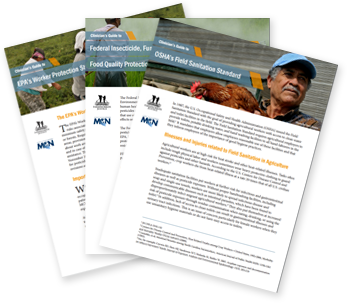
MCN and Farmworker Justice offer these guides to assist clinicians in understanding farmworker health and safety regulations. OSHA’s Field Sanitation Standard; EPA's Federal Insecticide, Fungicide, and Rodenticide Act (FIFRA); EPA's Food Quality Protection Act (FQPA); EPA’s Worker Protection Standard (WPS).
- OSHA's Field Sanitation Standard Clinician's Guide.pdf (747.53 KB)
- FIFRA FQPA Clinician Guide.pdf (287.9 KB)
- WPS Clinician's Guide.pdf (843.35 KB)
Este diccionario ilustrado bilingüe de MCN, "Seguridad en Palabras/ Safety in Words", muestra los peligros que hay en el lugar de trabajo y las mejores prácticas para la salud y la seguridad en la agricultura. Desarrollado con el apoyo del Programa de Subvenciones Susan Harwood de OSHA, este recurso refuerza el vocabulario en inglés de los trabajadores que hablan español lo que ayudará a prevenir lesiones en la agricultura.
DATE RECORDED: Wednesday, June 17, 2014
PRESENTED BY: Matthew Keifer, MD, MPH, Dean Emanuel Endowed Chair/Director National Farm Medicine Center
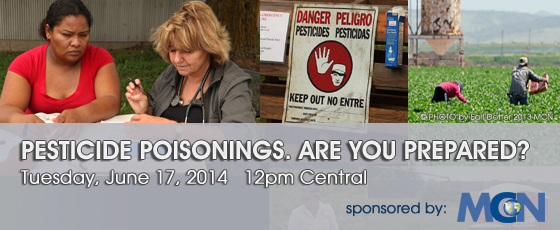 |
|
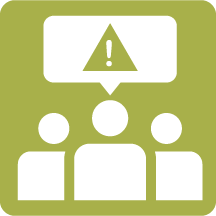 MCN’s Environmental and Occupational Health Programs
MCN’s Environmental and Occupational Health Programs
Learn more about MCN’s training and technical assistance programs to help clinicians and health centers improve the recognition and management of pesticide exposures and other environmental/occupational health conditions.
Mistakes can be dangerous. Accurate identification of pesticides responsible for a patient's illness is important to avoid iatrogenic errors with respect to acute treatment. Join us for an important webinar that will focus on key decision points in the diagnosis of pesticide exposures and emphasize the usefulness of the newly revised resource for clinicians - The Recognition and Management of Pesticide Poisonings, 6th ed. Through interactive case studies, this webinar will illustrate effective recognition and treatment of patients over exposed to pesticides.
The webinar, sponsored by Migrant Clinicians Network, the National Farm Medicine Center and AgriSafe Network features Dr. Keifer, a board certified occupational medicine specialist and internationally renowned researcher regarding pesticides and agricultural health and safety. For over 30 years, Dr. Keifer has focused his clinical practice and research largely on farmworkers.
SPONSORED BY: AgriSafe Network, Migrant Clinicians Network, and the National Farm Medicine Center
OBJECTIVES: Participants will be able to:
- Better recognize the signs and symptoms of pesticide overexposure
- Identify key decision points in diagnosing pesticide exposures
- Demonstrate an understanding of how to use The Recognition and Management of Pesticide Poisonings, 6th ed. in a clinical setting
We encourage all participants to order The Recognition and Management of Pesticide Poisonings, 6th ed. prior to attending this webinar. Order here. PDF versions are also available at http://www2.epa.gov/pesticide-worker-safety/recognition-and-management-pesticide-poisonings
If you have experienced any trouble ordering your copy please contact: kbrennan@migrantclinician.org
CLINICAL TOOLS & RESOURCES |
|
PATIENT EDUCATION MATERIALS |
|
ARCHIVED WEBINARS & TRAINING RESOURCES |
|
LOCAL PESTICIDE RESOURCES |
|
The following will provide information regarding the pesticides used in your areas:
|
- http://migrantclinician.adobeconnect.com/p77irjl7cvq/
- http://www.marshfieldclinic.org/nfmc/
- http://www.agrisafe.org/
- http://1.usa.gov/1aF9rHY
- http://www2.epa.gov/pesticide-worker-safety/recognition-and-management-pesticide-poisonings
- http://1.usa.gov/1fFUSZm
- http://bit.ly/1imO43V
- http://npic.orst.edu/
- http://www.aapcc.org/
- http://extoxnet.orst.edu/
- http://www.pesticidemededucation.com/
- http://www.extension.umn.edu/agriculture/pesticide-safety/program-team/
- http://www3.extension.umn.edu/county
- http://web.extension.illinois.edu/psep/about/psepteam.cfm
- http://web.extension.illinois.edu/state/findoffice.cfm
This colorful bilingual comic addresses workers' compensation and immigrant dairy farm workers’ rights and responsibilities. It tells the story of a Mexican dairy farm worker who is injured on the job and the steps he and his employer take to make sure he receives his benefits, and the farm improves its safety.
- DairyWrkrRightsWrkComp_ENG2016_web.pdf (7.78 MB)
- DairyWrkrRightsWrkComp_ESP2016_web.pdf (7.92 MB)
- COMIC - Safety and Health on the Farm - New Mexico - English.pdf (3.4 MB)
- COMIC - Safety and Health on the Farm - New Mexico - Spanish.pdf (3.41 MB)
- COMIC - Safety and Health on the Farm - New York - English.pdf (3.45 MB)
- COMIC - Safety and Health on the Farm - New York - Spanish.pdf (3.46 MB)
- COMIC - Safety and Health on the Farm -Minnesota -English.pdf (7.78 MB)
- COMIC - Safety and Health on the Farm - Minnesota - Spanish_0.pdf (7.91 MB)
MCN's Director of Environmental and Occupational Health, Amy K. Liebman, appeared on the radio broadcast Epicenter: West Marin Issues on KWMR 90.5 FM to talk pesticides and the Worker Protection Standard. Liebman was joined by Hector Sanchez of the Labor Council for Latin American Advancement. Host Frederick Smith discusses with Liebman and Sanchez a variety of pesticide-related issues, including protections for farmworkers and their families, farmworkers' risks of pesticide exposures, how pesticides are regulated, their health effects on farmworkers and their families, and what healthcare providers can do to mitigate, diagnose, manage, and report pesticide exposures.
During the interview Liebman referenced the Agricultural Health Study, which is available here.
- http://kwmr.org/show/186
- http://kwmr.org/show/186','','location=yes,scrollbars=yes,menubar=yes,resizable=yes,width=960,height=720,left='+(screen.availWidth/2-480)+',top='+(screen.availHeight/2-360)+
- http://www.lclaa.org/
- http://aghealth.nih.gov/
- http://aghealth.nih.gov/','','location=yes,scrollbars=yes,resizable=yes,width=960,height=720,left='+(screen.availWidth/2-480)+',top='+(screen.availHeight/2-360)+
- https://w.soundcloud.com/player/?url=http%3A//api.soundcloud.com/tracks/108699853
This website and training material were developed to give communities and promotores ways to help farm workers learn how to protect themselves from pesticide exposure.
The project and all materials on the website were developed by the California Poison Control System in collaboration with the the Western Center for Agricultural Health and Safety at the University of California, Davis and the California Department of Pesticide Regulation.

- DPR_Facilitator_Manual_EN.pdf (4.77 MB)
- DPR_Participant_Manual_EN.pdf (4.91 MB)
Señales y síntomas de envenenamiento por pesticidas
Developed by the California Poison Control System in collaboration with the Western Center for Agricultural Health and Safety at the University of California, Davis and the California Department of Pesticide Regulation
